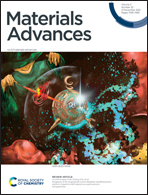Thienyltriazine based conjugated porous organic polymers: tuning of the porosity and band gap, and CO2 capture†
Abstract
A series of four thiophene and triazine containing conjugated porous polymers (CPPs) comprising the same building block, tris(thienyl)triazine, is synthesized using the alkyne cyclotrimerization reaction for TT-CPP1, Sonogashira coupling reaction for TT-CPP2, Glaser coupling reaction for TT-CPP3 and Stille coupling reaction for TT-CPP4. By varying the spacer between tris(thienyl)triazine units, the porosity (3.6, 4.8 and 5.3 nm, respectively) and the band gap value (2.43, 2.11 and 2.03 eV, respectively) of TT-CPP1, TT-CPP2 and TT-CPP3 have been efficiently tuned. All the TT-CPPs display significant thermal stability up to 450 °C. Nitrogen and sulfur of triazine and thiophene moieties, respectively, act as electron-donating centers in these porous polymer frameworks, resulting in excellent adsorption of the Lewis acidic CO2 molecule. A maximum CO2 uptake of 11.4 wt% (2.6 mmol g−1) at 263 K under 100 kPa pressure has been observed for TT-CPP1 compared to the other two CPPs due to the small pore size and strong adsorbate–adsorbent interactions. Configurational bias Monte Carlo (CBMC) molecular simulations have shed light on the selective capture, position and binding energy of CO2 for TT-CPP1/2/3.



 Please wait while we load your content...
Please wait while we load your content...